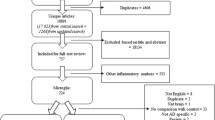Abstract
Hallmark lesions of Alzheimer disease (AD) are filled with reactive immunocompetent microglia, suggesting that immunological aderrations may participate in the pathophysiology of this disorder. If immune-mediated processes are closely linked to neuronal break-down, it would be of importance to have a reliable means to detect these processes. Cerebrospinal fluid (CSF) antibodies are discussed as such potential sources. The seredipitous use of the developing rat central nervous system (CNS) unexpectedly demonstrated that some AD CSF recognize amoeboid microglial cells. Similarly, AD CSF specifically stains activated microglia and neural macrophages in experimentally induced lesions. A cell-culture technique is described that allows rapid screening of CSF antibodies. Examination of CSF from a diversified dementia population revealed that AD CSF, in contrast to other dementia CSF, displayed remarkable selectivity toward microglial cells. Cortical biopsies from patients suspected to have AD were incubated with the patient's own CSF and that of confirmed AD patients. Both CSF samples recognized microglial cells in the cortical biopsy. AD CSF microglial antibodies appear to be significant in view of the increasing association between microglia and neuro degenerative processes in AD. These findings add further support to the concept that inflammation and similar immune mechanisms may contribute to to AD pathogenesis.
Similar content being viewed by others
References
Baldinger S. and Blumenthal H. T. (1982) Neuroimmunology of the aging brain, inGeriatrics (Platt D, ed.), Springer Verlag, Berlin, Germany, pp. 283–299.
Banati R. B., Schubert P., Rothe G., Gehrmann J., Rudolphi K., Valet G., and Kreutzberg G. W. (1994) Modulation of intracellular formation of reactive oxygen intermediates in peritoneal macrophages and microglia/brain macrophages by propentofylline.J. Cereb. Blood Flow Metab. 14, 145–149.
Cras P., Kawai M., Siedlak S., and Perry G. (1991) Microglia are associated the extracellular neurofibrillary tangles of Alzheimer's disease.Brain Res. 558, 312–314.
Dahlström A., McRae A., Polinsky R., Nee L., Sadasivan B., and Ling E. A. (1994) Alzheimer's disease cerebrospinal fluid antibodies display selectivity for microglia investigations with cell cultures and human cortical biopsies.Molecular Neurobiology 9, 41–54.
Dahlström A., Wigander A., Lundmark K., Gottfries C. G., and McRae A. (1990) Investigations on autoantibodies in Alzheimer's and Parkinson's diseases, using defined neuronal cultures.J. Neural Trans. (suppl) 29, 195–206.
Fudenberg H. H. and Singh V. (1988) Alzheimer's “Syndrome”: Prognosis of subsets with different etiology and preliminary effects of immunotherapy.Drug Dev. Res. 15, 165–174.
Guilian D. (1987) Ameoboid microglia as effectors of inflammation in the central nervous system.J. Neurosci. Res. 18, 155–171.
Haga S., Akai K., and Ishii T. (1989) Demonstration of microglial cells in and around senile (neuritic) plaques in the Alzheimer brain. An immunohistochemical study using a novel monoclonal antibody.Acta Neuropathol. 77, 569–575.
Ling E. A. and Wong W. C. (1993) The origin and nature of ramified and ameoboid microglia: A historical review and current concepts.Glia 7, 9–18.
Ling E. A., Kaur C., Yick T., and Wong W. (1990) Immunocytochemical localization of CR3 complement receptors with OX 42 in amoeboid microglia in postnatal rats.Anat. Embryol. 182, 481–486.
Ling E. A., Dahlström A., Polinsky R., Nee L., and McRae A. (1992a) Studies of activated microglia cells and macrophages using Alzheimer's disease cerebrospinal fluid in adult rats with experimentally induced lesions.Neuroscience 51, 815–825.
Ling E. A., Kaur C., and Wong W. C. (1992b) Expression of major histocompatibility complex antigens and CR3 complement receptors in activated microglia following an injection of ricin into the sciatic nerve in rats.Histol. Histopath 7, 93–100.
McGeer P. and Rogers J. (1992) Anti-inflammatory agents as a therapeutic approach to Alzheimer's disease.Neurology 42, 447–449.
McGeer P., Itagaki S., Tago H., and McGeer E. G. (1987) Reactive microglia in patients with senile dementia of the Alzheimer's type are positive for the histocompatibility glycoprotein HLA-DR.Neurosci. Lett. 79, 195–200.
McGeer P. L., Akiyama H., Itagaki S., and McGeer E. G. (1989) Immune system response in Alzheimer's disease.Can J. Neurol. Sci. 16, 516–527.
McRae A., Blennon K., Gottfries C. G., Walin A., and Dahlström A. (1990) Brain specific antibodies in the CSF of patients with Alzheimer's disease and other types of dementias, inBiological Markers in Dementia of Alzheimer Type (Fowler C. J., Carlson L. A., Gottfries C. G., and Winblad B., eds.), Smith-Gordon, London, pp. 135–148.
McRae A., Ling E. A., Polinsky R., Gottfries C. G., and Dahlström A. (1991) Antibodies in the cerebrospinal fluid of some Alzheimer's disease patients recognize amoeboid microglial cells in the developing rat central nervous system.Neuroscience 41, 739–752.
McRae A., Rudolphi K., and Keil M. (1993) Forebrain ischemia in monogolian gerbil: a model to investigate Alzheimer's disease microglial antibodies and amyloid,Soc. Neurosci. Abstract 19, 623.
McRae A., Rudolphi K. A., and Schubert P. (1994) Propentofylline depresses amyloid and Alzheimer's CSF microglial antigens after ischemia,NeuroReport 5, 1193–1196.
Morioka T., Kalehua A. N. and Streit W. J. (1992) Progressive expression of immunomolecules on microglial cells in rat dorsal hippocampus following transient forebrain ischemia,Acta Neuropathol. 83, 149–157.
Rio-Hertega P. del. (1932) Microglial, inCytology and Cellular Pathology of the Nervous System, Vol. 2 (Penfield W., ed.), Paul B Hoeber, New York, pp. 481–584.
Rogers J., Luber-Narod J., Styren S., and Civin H. (1988) Expression of immune system-associated antigens by cells of the human central nervous system: relationship to the pathology of Alzheimer's disease.Neurobiol. Aging 9, 339–349.
Selkoe D., Ihara Y., and Salazar F. J. (1982) Alzheimer's disease: Insolubility of partially purified paired filaments helical in sodium dodecyl sulfate and urea.Science 215, 1243–1245.
Shu S., Ju G., and Fan L. (1988) The glucose oxidase-DAB-nickel method in peroxidase histochemistry of the nervous system.Neurosci. Lett. 85, 169–171.
Wigander A., Lundmark K., McRae A., Dahlström A., and Ahlman H. (1989) Survival of rat fetal cholinergic neurons co-cultured with human midgut carcinoid tumour cells.Acta Scand. Physiol. 136, 291–292.
Author information
Authors and Affiliations
Rights and permissions
About this article
Cite this article
McRae, A., Ling, E.A., Wigander, A. et al. Microglial cerebrospinal fluid antibodies. Molecular and Chemical Neuropathology 28, 89–95 (1996). https://doi.org/10.1007/BF02815209
Received:
Accepted:
Published:
Issue Date:
DOI: https://doi.org/10.1007/BF02815209




